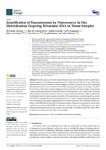2022-03-11Zeitschriftenartikel
Identification of Mucormycosis by Fluorescence In Situ Hybridization Targeting Ribosomal RNA in Tissue Samples
Dalimot, Jill Jasmine
Smith, Ilka Mc Cormick
Gerkrath, Jasmin
Hartmann, Sylvia
Cornely, Oliver A.
Lee, Soo Chan
Heitman, Joseph
Rickerts, Volker
Mucormycosis is an invasive fungal infection associated with high mortality, partly due to delayed diagnosis and inadequate empiric therapy. As fungal cultures often fail to grow Mucorales, identification of respective hyphae in tissue is frequently needed for diagnosis but may be challenging. We studied fluorescence in situ hybridization (FISH) targeting specific regions of the fungal ribosomal RNA (rRNA) of Mucorales to improve diagnosis of mucormycosis from tissue samples. We generated a probe combination specifically targeting Mucorales. Probe specificity was verified in silico and using cultivated fungi. Mucorales hyphae in tissue of a mouse model demonstrated a bright cytoplasmatic hybridization signal. In tissue samples of patients with mucormycosis, a positive signal was seen in 7 of 12 (58.3%) samples. However, autofluorescence in 3 of 7 (42.9%) samples impaired the diagnostic yield. Subsequent experiments suggested that availability of nutrients and antifungal therapy may impact on the FISH signal obtained with Mucorales hyphae. Diagnosis of mucormycosis from tissue might be improved by rRNA FISH in a limited number of cases only. FISH signals may reflect different physiological states of fungi in tissue. Further studies are needed to define the value of FISH to diagnose mucormycosis from other clinical samples.

